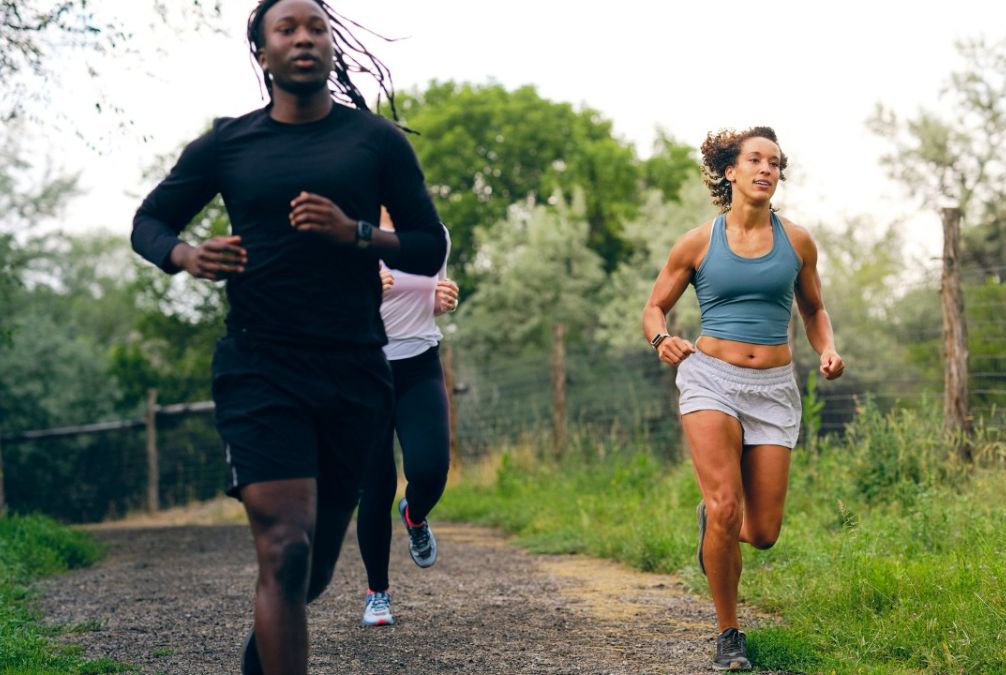There are some sorts of runs that you simply come throughout the place even the fundamentals may be difficult to grasp, like threshold or tempo runs. Others are simpler to get a deal with on, like interval working and certainly lengthy runs, as a result of most of us perceive that the latter contain working for an extended distance or time period than regular.
Nonetheless, there’s quite a bit to be taught past the fundamentals of lengthy runs to be sure to’re doing them proper, and if you’re following a marathon or half marathon coaching plan it’s important that you simply nail your lengthy runs to be ready for race day.
To reply any questions on lengthy runs you might need, with a deal with lengthy runs as a part of marathon coaching, we spoke to working coach and Saucony ambassador Nick Anderson, who’s additionally the founding father of runningwithus.com (opens in new tab), a workforce of skilled coaches.
What are the advantages of lengthy runs?
From a purely physiological standpoint, they construct cardio health: extra pink blood cells, better capillarisation within the muscle tissues, mitochondria get stronger – all offering you’re working slowly and sensibly.
You additionally train your physique to make use of power cleverly. Have a very good pre-long-run breakfast and eat effectively within the days earlier than, then exit at a slower tempo to be sure to’re burning fatty acids in your bloodstream concurrently burning your glycogen shops. If you happen to run too quick, you’ll solely burn carbohydrates [glycogen]. If you happen to run at a smart tempo, you’ll burn each of these extra successfully, so that you’ll unfold the period of time that your glycogen shops present power for you.
How lengthy ought to a future in a marathon coaching plan be?
Most marathon coaching plans assume you possibly can already run as much as 5K in coaching, so construct progressively from there. If you happen to can run for about 90 minutes to 2 hours if you’re 10 to 12 weeks out from the marathon, whether or not it’s stroll/working or straightforward working, you’re in an excellent place.
You shouldn’t be seeking to cowl the complete distance in marathon coaching in your future. A couple of elite athletes will do it, however most don’t. Your future is growing the flexibility to spend a very long time in your toes to make the gap achievable.
To your longest future – how lengthy is a chunk of string? It’s totally different for everybody, however someplace between 16 and 22 miles. I say that as a result of your longest run in marathon coaching, which is likely to be three or 4 weeks earlier than the race, shouldn’t be for much longer than about 3½ hours. Any longer and also you wrestle to get well from that coaching run after which three or 4 weeks later, you’re nonetheless drained.
A more recent runner who’s maybe taking 5 to 6 hours to run a marathon may solely get to 16 or 17 miles in coaching. They could panic however the actuality is, with all the different coaching, they are going to be nice on the day.
Do you have to nonetheless do lengthy runs when you’re not coaching for a marathon?
I’m working with a number of several types of runners and the long term continues to be a key part. You need to keep up a correspondence along with your longer lengthy runs all year long, however not be doing a great deal of them. So when you’re a marathon runner who’s going right into a interval of 5K, 10K work, you’re in all probability trying extra in the direction of 90 minutes on your future, however now and again going as much as two hours simply to keep up a correspondence with that form of endurance.
Typically, a future of 80-90 minutes for anybody who’s coaching for 5K, and even shorter distances on the monitor, is nice. It builds extra pink blood cells, it builds the foundations of endurance. A 1,500m race continues to be an endurance occasion. It’s simply that you simply run in a short time.
How briskly do you have to run your lengthy runs?
I feel most runners run their longer runs too exhausting within the early weeks of coaching. They exit and do their regular run tempo and simply do it for longer. That’s doing two unhealthy issues. To start with it’s inflicting extra harm for an extended time period. And we don’t need that. And the second factor is it’s not educating our physique to turn into higher fat-adapted. So the slower we run, the higher we’re going to get at working with fat and carbohydrates.
If you happen to’re an skilled runner, decelerate to 30, 45 or possibly even 60 to 90 seconds per mile slower than your deliberate marathon tempo in your lengthy runs.
For the not-so-experienced runner I at all times say run on the pace of chat. If you happen to can’t speak simply, you’re working too exhausting and also you’re burning an excessive amount of carbohydrate, somewhat than saved fat and carbohydrates on the similar time.
Within the closing 10 to 12 weeks, the runner who’s bought a goal or could be very skilled can begin to construct in blocks at marathon tempo into their future. Possibly put some marathon tempo in throughout the second half of your future, since you’ve bought to get higher at working tougher like you’ll within the second half on marathon day.
You can even take into account development runs the place the tempo will progressively construct in the long term as a result of on marathon day you’re going to should progressively work tougher to keep up the identical tempo. You may even begin to put some blocks in which can be barely tougher than marathon tempo.
No matter you do, I feel it is best to line up on occasion day having achieved quite a few reps within the final 10 to 12 weeks the place you have got practised your marathon tempo. If you happen to’re a goal runner who’s going for a time it is best to stand there assured you possibly can maintain this tempo and actually consider it.
What and when do you have to eat earlier than a future?
It’s so private. I’ve seen the world’s greatest athletes eat porridge, bananas, bagels, power bars and stuff like that. Use no matter goes to provide you a very good quantity of carbohydrate that you may simply digest and sits comfortably. I used to typically have a plain bowl of pasta for breakfast, as a result of it’s only a lump of gas that’s going to provide you power.
What you don’t need to do is simply copy what another person is doing after which bail out to the toilet as a result of there’s an excessive amount of fibre. Porridge is likely to be a problem the place it’s advantageous for others. Be sure to’re comfy with it and take a look at it in your whole lengthy runs.
Additionally I feel a giant mistake individuals make is that they deal with the breakfast, however they haven’t considered what they needed to eat the night time earlier than and possibly the afternoon earlier than. One of many causes you may undergo with intestine points couldn’t be the breakfast, however often because there was an excessive amount of fibre, maybe too many greens, and an excessive amount of protein within the meal you had within the afternoon or the night earlier than.
I might have a look at extra beige, bland carbohydrates which can be straightforward to digest, decreasing the quantity of protein and only a very gentle quantity of greens the afternoon and night time earlier than as effectively. So every little thing’s very settled. It’s very boring. It’s simply gas.
How do you gas throughout a future?
I work on the premise {that a} gel each 30 to 45 minutes might be as a lot as your intestine will tolerate. Some individuals can do a bit extra. The largest mistake individuals make is that they overlook the enzymes within the intestine are already very, very irritated since you’re bouncing up and down as you run. You’re going by a number of totally different processes that enzymes are having to cope with metabolically as you’re working. Then you definitely introduce a load of sugar to the intestine – and very often individuals whack the gel down prefer it’s a Jägerbomb – and out of the blue 40g of carbohydrate is hitting the abdomen wall and the physique can’t cope with it. Additionally, it’s not going to soak up all of it.
The unwanted effects of which can be abdomen ache, needing to go to the toilet, feeling nauseated. The most effective factor you could possibly do is to sip on a gel and take 5 to 10 minutes to complete it. Then the absorption charges are larger.
A whole lot of physiologists and dietitians will discuss you having the ability to take in about 60g of carbohydrate an hour when you’re performing. I might argue that that’s OK when you’re very a lot in management. For athletes actually pushing exhausting and getting nearer to the highest finish of their threshold zone, what you possibly can tackle and tolerate will get tougher and tougher to do, which is why a number of elite athletes have a tendency to make use of liquid sports activities drinks as a result of they’re simpler to tackle than gels.
If you end up a more recent runner, you’re going to be working exhausting, however your coronary heart price shall be a bit decrease and it ought to be simpler so that you can take in your gels and handle that complete course of. So it turns into a recreation of how a lot you possibly can absorb an hour that’s comfy. You may begin to get nearer to 60g which is an effective factor since you’re going to be out for longer.
How a lot water do you have to drink on a future?
I’m a fan of ingesting to thirst or simply forward of it. I feel individuals can consolation drink when there’s drink stations each mile within the main metropolis marathons. The truth is when you drink to thirst, it’s higher.
Water is unbelievable, however to hydrate when performing take into account including issues like electrolyte tablets which can be going to have extra sodium, potassium, magnesium in them, with out sugar. It’s going to show your water into one thing that the enzymes are extra enthusiastic about. So the absorption charges are larger and hydration charges are higher.
It’s higher to drink little and infrequently of these drinks than to drink a number of water, which ultimately doesn’t have the correct impact, notably when it’s hotter. And in excessive circumstances if you drink an excessive amount of water, it could actually induce hyponatremia.
Do you have to attempt to replicate marathon situations in your lengthy runs?
I sometimes get messages from a few of my extra critical runners saying they struggled to hit marathon tempo at this time. So we have a look at it and often discover the profile of the route was unsuitable. It was undulating or hilly, or they have been working into the wind throughout the marathon tempo part. Or a big a part of that run was exhausting earlier than the marathon tempo section so that they have been already too drained by the point they bought there.
I feel if you get to your key runs, that’s the place you’ve bought to make it a very good floor. highway in a quiet space, so that you’re not stopping and beginning crossing roads. Take into consideration the wind path slightly bit. Make it completely achievable on your marathon tempo so it feels managed.
Whenever you exit and simply run straightforward or regular, then these runs may be off-road and/or undulating, it’s in all probability good so that you can preserve you sturdy.
Do you have to use your marathon footwear throughout lengthy runs in coaching?
It’s actually related for the time being due to the super-shoe state of affairs. I see a number of runners doing lengthy runs within the unsuitable footwear. In the course of your closing 10 weeks, when you’re going to put on a carbon plate shoe just like the Saucony Endorphin Professional 3 on race day, then you must do a couple of lengthy runs in that shoe. You’ve bought to turn into environment friendly at working in that shoe at marathon tempo for as much as two hours and past. You’ve bought to have gone as much as 30km in your marathon alternative of shoe and comprehend it’s nonetheless comfy, as a result of it’s what occurs after 20km that can decide whether or not that shoe will give you the results you want.
How do you get well after a future?
Concentrate on diet if you get again. Begin with a restoration drink, whether or not it’s your individual designed milkshake, or a sports activities drink with electrolytes, protein and carbs in it.
At some stage on the day after it’s good to stretch or foam roll and I feel it is best to go for a stroll to get every little thing transferring once more. The improved circulation from that then hastens restoration. Some individuals will use compression clothes and totally different excessive restoration processes. They work, so take into account that as effectively. If you need an ice bathtub, there appears to be some proof they have an impact however I’ll say you’re fairly courageous!
The longer your future, the longer you are taking to get well. Be certain the subsequent day or two are straightforward. I might by no means advise doing a tougher coaching session the day after a future. I see lots of people doing a future on Sunday, then they’re on the membership on a Tuesday making an attempt to run exhausting and questioning why the session is just not going effectively. They’re selecting up accidents or diseases, notably accidents. You’re very vulnerable to accidents within the day or two after your future.
Sleep effectively, get your power ranges again up, and be ready to maneuver your subsequent good-quality session or run later within the week that follows.
How To Nail Your Restoration After A Lengthy Run
- Use This Operating Restoration Routine After A Run To Assist You Recuperate Sooner
- Use Laura Muir’s Restoration Smoothie Recipe To Refuel After Your Hardest Runs
- Stretches For Runners To Assist Pace Up Your Restoration
- Use These Publish-Run Stretches To Recuperate After Your Coaching
- Stretch Your Aching Muscle tissue With This Publish-Run Yoga Routine
- Important Foam Rolling Workouts For Runners






